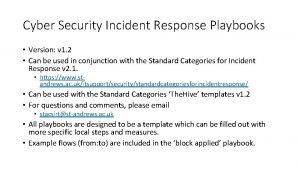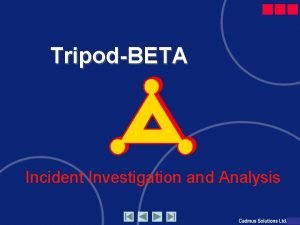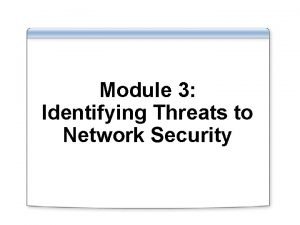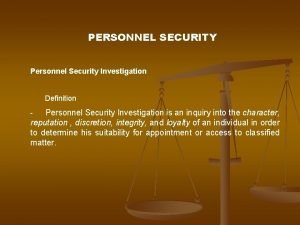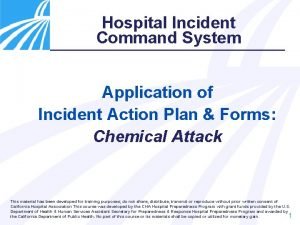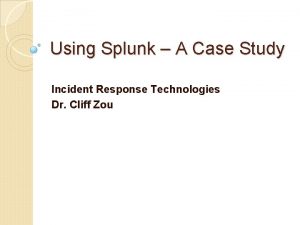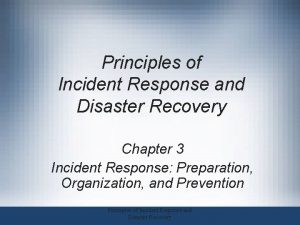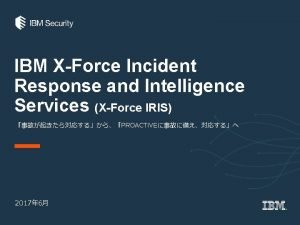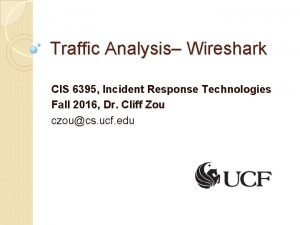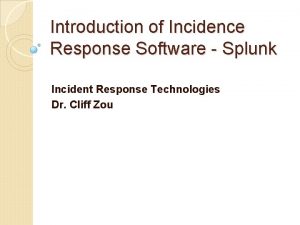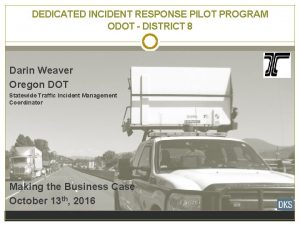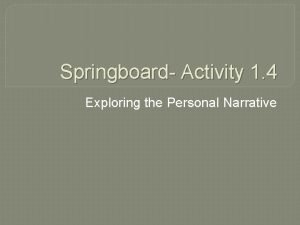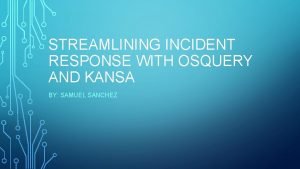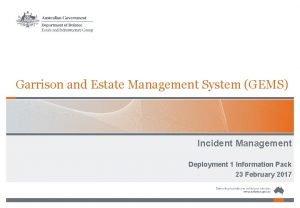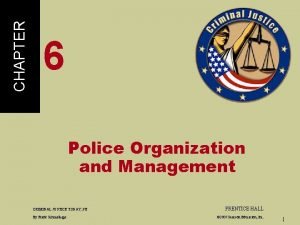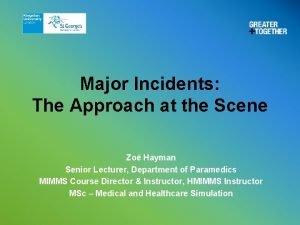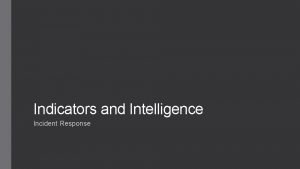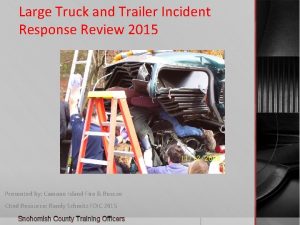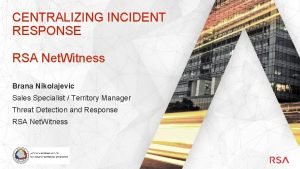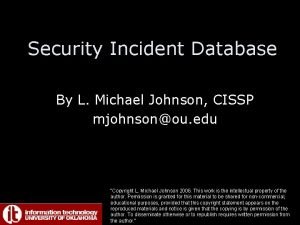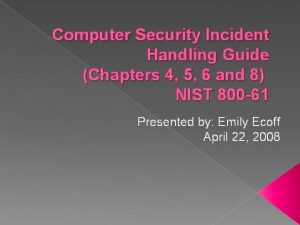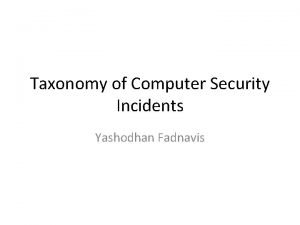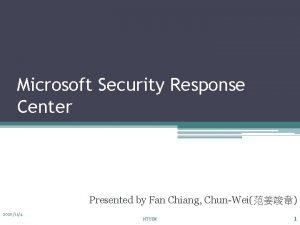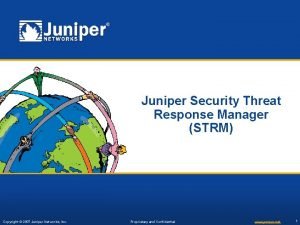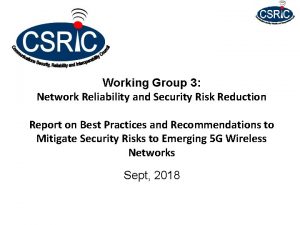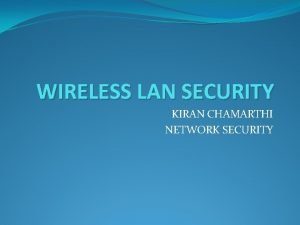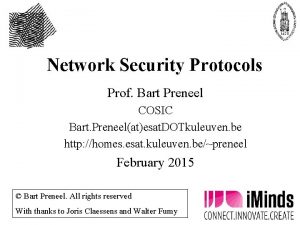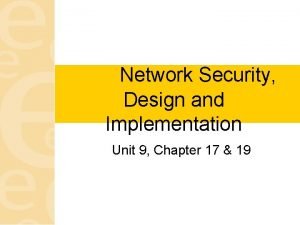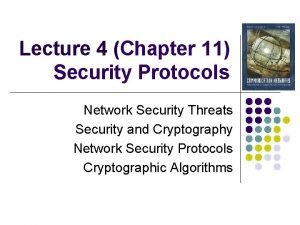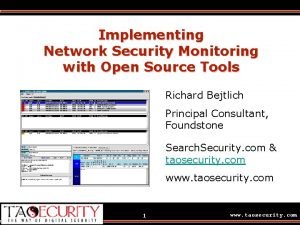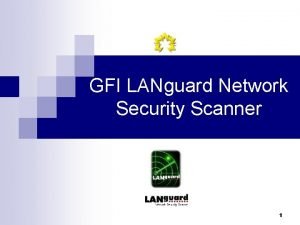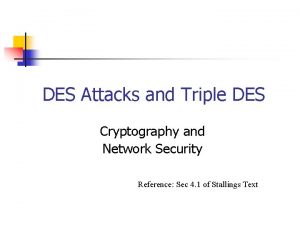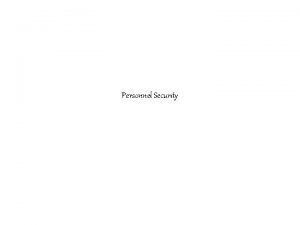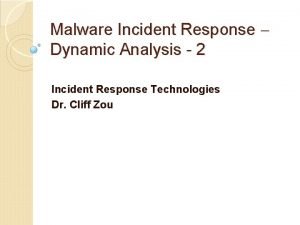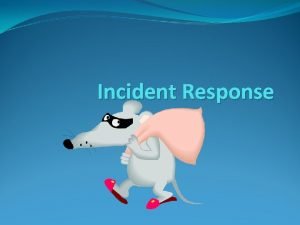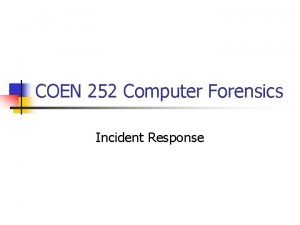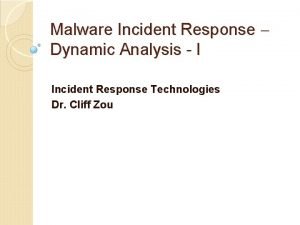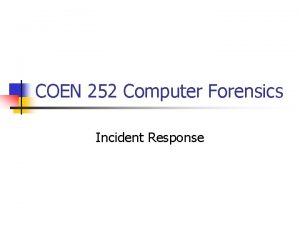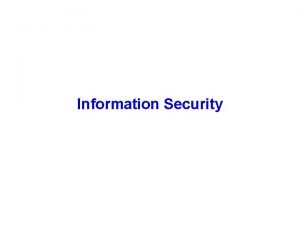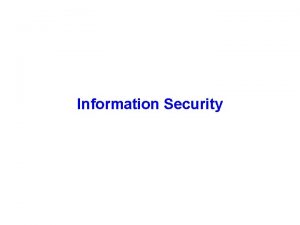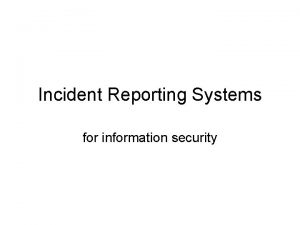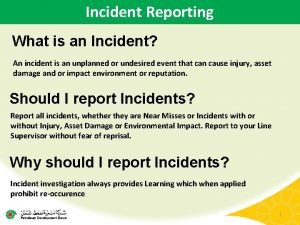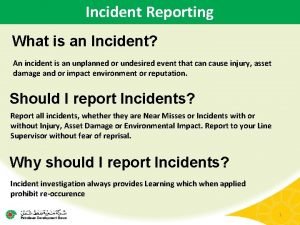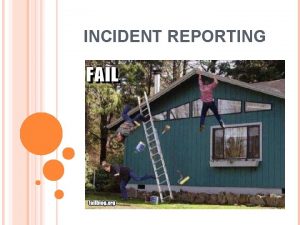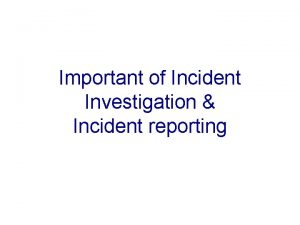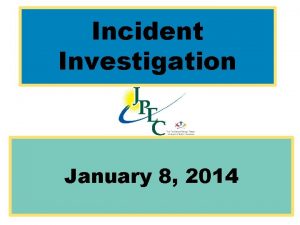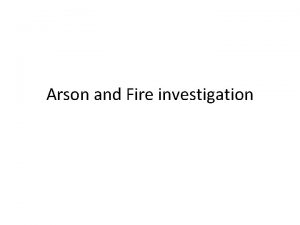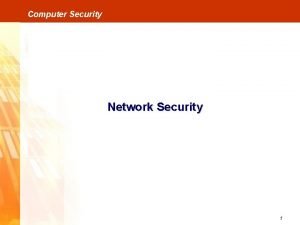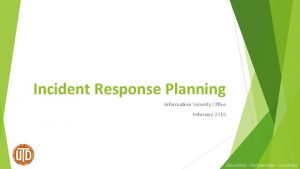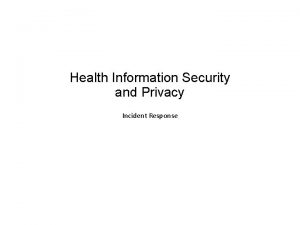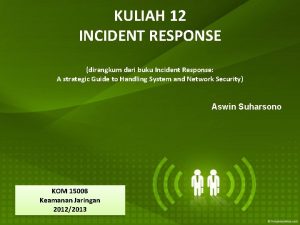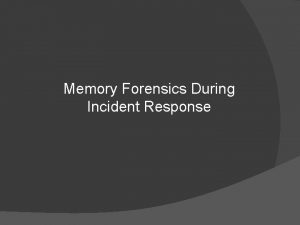Network Incident Response Information Security Incident Investigation For

















































![Base 64 Encoding if (preg_match('/live|msn|yahoo|google|ask|aol/', $_SERVER["HTTP_REFERER"])) { $tabs = array ('viagra', 'cialis', 'levitra', 'propecia', Base 64 Encoding if (preg_match('/live|msn|yahoo|google|ask|aol/', $_SERVER["HTTP_REFERER"])) { $tabs = array ('viagra', 'cialis', 'levitra', 'propecia',](https://slidetodoc.com/presentation_image_h/a66db4383cb23dd2aff7e97f4c639ade/image-50.jpg)





![Mod-Sec SQL Injection --346 e 283 e-A--[04/Aug/2008: 02: 30: 00 --0700] @7 e. QMYP Mod-Sec SQL Injection --346 e 283 e-A--[04/Aug/2008: 02: 30: 00 --0700] @7 e. QMYP](https://slidetodoc.com/presentation_image_h/a66db4383cb23dd2aff7e97f4c639ade/image-56.jpg)



































































- Slides: 123

Network Incident Response Information Security Incident Investigation For 2010 NWACC Security Workshop Craig Schiller, CISSP-ISSMP, ISSAP Network Forensics & Incident Response 1

Agenda Introduction Incident Response Network Forensics & Incident Response 2

Incident Response Required by most security policies Most require a formal Incident Response plan You should have several means of discovering incidents Network Forensics & Incident Response 3

Incident Response Who’s watching your network? Network Forensics & Incident Response 4

Incident Response Network Forensics & Incident Response 5

Incident Detection A/V, Anti-Spam, Anti-Spyware Host based Security logs RUBotted – Trend Micro Enterprise Reporting User Help Desk Tickets Abuse notifications Quasi-Intelligence Organizations Monitoring & Analysis Ourmon Firewall & Router logs IDS/IPS – Host and Network Darknets, Honeypots DNS Server & Workstation Log analysis Malware analysis (Sandbox) Forensics Network Forensics & Incident Response 6

Investigative Process Model Persuasion and Testimony Assessment Experiment Fusion Correlation Validation Reporting Analysis Organization and Search Reduction (Filtering) Harvesting Examination Recovery Preservation Case Management Steps Identification or Seizure Incident/Crime Scene Protocols Assessment of Worth Accusation or Incident Alert Network Forensics & Incident Response 7

Operation Aching Mules Network Forensics & Incident Response 8

Operation Aching Mules NYPD detectives entered a Bronx bank in February to investigate a suspicious $44, 000 withdrawal. International investigation began in Omaha, in May when fraudulent ACH payments were made to 46 bank accounts Cyber-attacks began in Eastern Europe, sending apparently-benign email to computers at small businesses and municipalities in the US Clicking on a link downloaded Zeus The malware recorded their keystrokes as they logged into their bank accounts online Hackers made unauthorized transfers of thousands of dollars at a time to receiving accounts controlled by the co-conspirators. Once the victim/employee begins executing an online banking transaction on behalf of his or her employer, Zeu. S invisibly also executes a fraudulent wire transfer, usually for $10, 000 or less. Network Forensics & Incident Response 9

Operation Aching Mules Money Mules Receiving accounts were set up by a "money mule organization" responsible for retrieving the proceeds of the malware attacks and transporting or transferring the stolen money overseas. The money mule organization recruited individuals who had entered the United States on student visas, provided them with fake foreign passports, and instructed them to open false-name accounts at U. S. banks. Once these false-name accounts were successfully opened and received the stolen funds from the accounts compromised by the malware attacks, the "mules" were instructed to transfer the proceeds to other accounts, most of which were overseas, or to withdraw the proceeds and transport them overseas as smuggled bulk cash. Network Forensics & Incident Response 10

Operation Aching Mules U. S. authorities charged 92 Russians and Eastern Europeans who allegedly opened U. S. bank accounts expressly to receive cash transferred from hacked online banking accounts. The defendants charged in Manhattan federal court include managers of and recruiters for the money mule organization, an individual who obtained the false foreign passports. 19 Eastern Europeans were arrested in the UK. The Ukrainian SBU arrested 5 key subjects of the investigation. $70 M over the last four years. Network Forensics & Incident Response 11

VIF/BOT scenario Network Forensics & Incident Response 12

Incident Detection examples Reports from Anti-Virus Enterprise server 1. today, Mcafee, 131. 252. 243, pri=hi, JS/Wonka [**] [1: 3111116: 1] Mcafee http feed: : http: //bluebookcarpices. com/ <http: //pices. com/> (JS/Wonka) [**] [Classification: access to a potentially vulnerable web application] [Priority: 2] 05/21 -08: 13: 56. 950979 131. 252. 243: 52733 -> 216. 240. 128. 250: 80 TCP TTL: 63 TOS: 0 x 0 ID: 38398 Ip. Len: 20 Dgm. Len: 568 DF ***AP*** Seq: 0 x. D 222814 A Ack: 0 x 278524 DD Win: 0 x. FFFF Tcp. Len: 32 TCP Options (3) => NOP TS: 345145726 2079777105 Reports from Intrusion Detection System (IDS) 2. today, zlob, 131. 252. 243. 80, pri=hi [**] [1: 666666: 1] zlob dns request [**] [Classification: Potentially Bad Traffic] [Priority: 2] 05/21 -09: 50: 22. 532193 131. 252. 243. 80: 49190 -> 85. 255. 115. 29: 53 UDP TTL: 63 TOS: 0 x 0 ID: 3755 Ip. Len: 20 Dgm. Len: 73 Len: 45 Network Forensics & Incident Response 13

Forensics/Internal Intel Gathering • Quick Forensics • Process Explorer • TCPView • Auto. Runs • Process Monitor • Rpier – First Responder Tool • Automated Forensics • Consistent information gathered regardless of who runs it • Sleuthing • How did they get in? • What does it do? • What files are used? • When did what happen? • Malware Analysis • More Sleuthing Network Forensics & Incident Response 14

Security Event log I checked and I didn’t see anything Network Forensics & Incident Response 15

Forensics/Intel Gathering example Process PID CPU Description Company Name System Idle Process 0 93. 36 Interrupts n/a 1. 56 Hardware Interrupts DPCs n/a Deferred Procedure Calls System 4 0. 39 smss. exe 508 Windows NT Session Manager Microsoft Corporation csrss. exe 620 Client Server Runtime Process Microsoft Corporation winlogon. exe 884 Windows NT Logon Application Microsoft Corporation services. exe 944 Services and Controller app Microsoft Corporation svchost. exe 1180 Generic Host Process for Win 32 Services Microsoft Corporation wmiprvse. exe 3400 WMI Microsoft Corporation svchost. exe 1252 Generic Host Process for Win 32 Services Microsoft Corporation svchost. exe 1312 Generic Host Process for PSXSS. EXE 896 Interix Subsystem Server Microsoft Corporation init 2156 Interix Utility Microsoft Corporation inetd 2432 Interix Utility Microsoft Corporation iexplorer. exe 3560 explorer. exe 8564 Windows Explorer Microsoft Corporation cc. App. exe 9208 Symantec User Session Symantec Corporation VPTray. exe 8636 Symantec Anti. Virus Symantec Corporation VPC 32. exe 9524 Symantec Anti. Virus Symantec Corporation iexplorer. exe 6712 sqlmangr. exe 9904 SQL Server Service Manager Microsoft Corporation Network Forensics & Incident Response 16

Forensics/Intel Gathering example Network Forensics & Incident Response 17

Forensics/Intel Gathering example Network Forensics & Incident Response 18

Forensics/Intel Gathering example Strings in the file iexplorer. exe Strings in memory Network Forensics & Incident Response 19

Analyzing the Malware CWSandbox Analysis Network Forensics & Incident Response 20

Carsten Willem’s CWSandbox Ubuntu VMWare XP Pro Network Forensics & Incident Response 21

The Future Network Forensics & Incident Response 22

Movie BUM 60. MOV Network Forensics & Incident Response 23

Spearphishing scenario Network Forensics & Incident Response 24

Spearphishing investigative model Investigation Method Step Spearphishing Response Scenario Accusation or Incident Alert Notify – Make it easy for detection and notification to occur. Assessment of Worth Prioritize this incident in relation to other work of the organization. Incident/Crime Scene Protocols Begin the process of ensuring the admissibility of evidence Detection Identification or Seizure Using the protocols established above, ensure that all potential network evidence is identified and documented. Analysis Preservation Document the incident and open an incident ticket – Notify wormwatch Recovery Identify and collect potential evidence from network and enterprise systems. Harvesting Use experience to examine the collected data and identify class characteristics that might contribute to the investigation Reduction Use the output of the Harvesting step to extract phishing site specific network traffic entries from evidence sources (firewall logs, tcpdump, Ourmon logs, Net Flow data, etc. ) Organization and Search Use consistent naming schemes and folder hierarchies. Make it easier for the investigator to find and identify data during the Analysis investigation step. Enable repeatability and accuracy of subsequent analysis. Analysis Analyze the timeline (temporal analysis), the relationships between the phisher’s IP addresses and other attacks (relational analysis), conditions or data that might tend to make the incident possible or impossible (functional analysis). Analyze the IP addresses to ID source. Determine why this victim was selected (Victimology). Preparation Network Forensics & Incident Response 25

Spearphishing investigative model Containment, None Triage – stop the bleeding. Identify the compromised account owner. Keep future attempts using the attack vector from reaching their intended target. Feed the attackers IP addresses to local detection software and networking. Contact IP related ISPs or host organizations Eradication None Search mail systems for other compromised accounts. Locate and re-image any system that downloaded malware Recovery None Recover the compromised account. Prevent the attackers from continuing to use the compromised accounts. Return the users system to normal operation. Educate the users on spearphisher techniques and how to recognize them Post-Incident Activity Reporting Contact Law Enforcement Feed the attackers IP addresses to intelligence aggregation organizations Persuasion and Testimony Prepare presentations and brief executive management. Give awareness presentations to relevant stakeholders. Network Forensics & Incident Response 26

Spearphishing email Network Forensics & Incident Response 27

Recover userful information You can extract the following information from the spearphishing email: The from and reply-to email addresses. The subject line and message ID The URL of the phishing site The originating IP address The domain of the phishing site Network Forensics & Incident Response 28

Spearphishing email Return-Path: <SDeloach@camden. k 12. ga. us> Received: from murder (beli. oit. pdx. edu [131. 252. 122. 1]) by backend 03. psumail. pdx. edu (Cyrus v 2. 2. 12) with LMTPSA (version=TLSv 1/SSLv 3 cipher=AES 256 -SHA bits=256/256 verify=YES); Tue, 13 Jul 2010 09: 40: 08 -0700 X-Sieve: CMU Sieve 2. 2 Received: from beli. oit. pdx. edu ([unix socket]) by psumail. pdx. edu (Cyrus v 2. 2. 13) with LMTPA; Tue, 13 Jul 2010 09: 40: 08 -0700 Received: from nithog. oit. pdx. edu (nithog. oit. pdx. edu [131. 252. 120. 55]) by beli. oit. pdx. edu (8. 14. 1+/8. 13. 1) with ESMTP id o 6 DGe 8 L 5014251 for <harterd@odin. pdx. edu>; Tue, 13 Jul 2010 09: 40: 08 -0700 Received: from gtwy. camden. k 12. ga. us (mail. camden. k 12. ga. us [168. 11. 97. 73]) by nithog. oit. pdx. edu (8. 14. 1+/8. 13. 1) with ESMTP id o 6 DGe 6 Ow 021644 for <harterd@pdx. edu>; Tue, 13 Jul 2010 09: 40: 07 -0700 X-Authentication-Warning: nithog. oit. pdx. edu: Host mail. camden. k 12. ga. us [168. 11. 97. 73] claimed to be gtwy. camden. k 12. ga. us Received: from gtwy. camden. k 12. ga. us (unknown [127. 0. 0. 1]) by IMSA (Postfix) with ESMTP id 62 BD 211014 E; Tue, 13 Jul 2010 12: 40: 05 -0400 (EDT) Received: from exchange 2. camden. k 12. ga. us (unknown [168. 11. 97. 41]) by gtwy. camden. k 12. ga. us (Postfix) with ESMTP id DF 3 E 711014 B; Tue, 13 Jul 2010 12: 40: 04 -0400 (EDT) X-Mime. OLE: Produced By Microsoft Exchange V 6. 5 Content-class: urn: content-classes: message MIME-Version: 1. 0 Content-Type: text/plain; charset="iso-8859 -1" Content-Transfer-Encoding: quoted-printable Subject: Mailbox Quota Date: Tue, 13 Jul 2010 12: 40: 03 -0400 Message-ID: <85 A 63 B 83 E 0776 A 4 E 8 D 5416 E 0 A 7 E 805490 BDBAA 2 D@exchange 2. camden. k 12. ga. us> From: "Sandra J. Deloach" <SDeloach@camden. k 12. ga. us> To: undisclosed-recipients: ; Network Forensics & Incident Response 29

Limit the damage Block outbound traffic to IP address Block by web filtering DNS Cache Poisoning Your DNS server could intercept and poison any responses to systems that lookup either domain. By replacing the actual DNS response with an address in your Darknet and instrumenting a system with that address you could gain a warning every time someone responded to the attack. Network Forensics & Incident Response 30

Spearphish Campaign spreadsheet Network Forensics & Incident Response 31

Phishing website Network Forensics & Incident Response 32

Gathering intelligence 100713 -spearphishing-passwords. saz Network Forensics & Incident Response 33

Gathering intelligence Network Forensics & Incident Response 34

Gather Intelligence Extracted passwords Network Forensics & Incident Response 35

Compromised Accounts (spammers) Network Forensics & Incident Response 36

Search Engine Spam – Victimless crime? Is it really victimless? Cheat the poor and technology weak out of their hard-earned money Operators of Search engine spam sites are linked to Child Porn Reputational damage and Do. S Network Forensics & Incident Response 37

Damage to Your University’s Reputation Network Forensics & Incident Response 38

Search Engine Spam Network Forensics & Incident Response 39

Search Engine Spam & Clicks 4 Hire Use Google to search for Clicks-4 -Hire relays and search engine spam site: yoursite. com -pdf -ppt -doc phentermine OR viagra OR cialis OR vioxx OR oxycontin OR levitra OR ambien OR xanax OR paxil OR "slot-machine" OR "texas-holdem" Network Forensics & Incident Response 40

Google site search results Network Forensics & Incident Response 41

Google Alerts Craigs@pdx. edu Network Forensics & Incident Response 42

Google Alerts Results Network Forensics & Incident Response 43

An owned webpage Network Forensics & Incident Response 44

Browser Intelligence gathering Network Forensics & Incident Response 45

Links to this web page Network Forensics & Incident Response 46

Fiddler sleuthing Network Forensics & Incident Response 47

Base 64 Encoding <? php eval(base 64_decode("ZXJyb 3 Jfcm. Vwb 3 J 0 a. W 5 n. KDAp. Ow 0 KJGJvd. F 9 sa. XN 0 ID 0 g. YXJy. YXko. Ijgu. Ni 40 OCIs. Ij. Yy. Lj. E 3 Mi 4 x. OTki. LCI 2 Mi 4 y. Ny 41 OSIs. Ij. Yz. Lj. E 2 My 4 x. M DIi. LCI 2 NC 4 x. NTcu. MTM 3 Iiwi. Nj. Qu. MTU 3 Lj. Ez. OCIs. Ij. Y 0 Lj. Iz. My 4 x. Nz. Mi. LCI 2 NC 42 O C 44 MCIs. Ij. Y 0 Lj. Y 4 Ljgx. Iiwi. Nj. Qu. Njgu. ODIi. LCI 2 NC 42 OC 44 My. Is. Ij. Y 0 Lj. Y 4 Ljg 0 Iiwi. Nj Qu. Njgu. OD Network Forensics & Incident Response 48

Base 64 Encoding Network Forensics & Incident Response 49
![Base 64 Encoding if pregmatchlivemsnyahoogoogleaskaol SERVERHTTPREFERER tabs array viagra cialis levitra propecia Base 64 Encoding if (preg_match('/live|msn|yahoo|google|ask|aol/', $_SERVER["HTTP_REFERER"])) { $tabs = array ('viagra', 'cialis', 'levitra', 'propecia',](https://slidetodoc.com/presentation_image_h/a66db4383cb23dd2aff7e97f4c639ade/image-50.jpg)
Base 64 Encoding if (preg_match('/live|msn|yahoo|google|ask|aol/', $_SERVER["HTTP_REFERER"])) { $tabs = array ('viagra', 'cialis', 'levitra', 'propecia', 'prozac', 'xenical', 'soma', 'zoloft', 'tamiflu', 'sildenafil', 'tadalafil', 'vardenafil', 'finasteride', 'hoodia', 'acomplia', 'phentermi ne', 'adipex', 'tramadol', 'ultram', 'xanax', 'valium', 'ambien', 'ativan', 'vicodin', 'hoodia', 'ac omplia'); $niche='unknown'; foreach($tabs as $tab) { if(preg_match("/$tab/", $_SERVER["HTTP_REFERER"])) Network Forensics & Incident Response 50

302 Error hijacking If the source of the highlighted URL differs from the source when you browse directly to the same page, then the spammers may be hijacking your Google response. Google hijacking presents a serious challenge to your eradication efforts as Google has not provided a process for dealing with these incidents. See the web page (http: //www. loriswebs. com/find-hijacker. html) for more information about 302 errors and Google hijacking. She also has directions for reporting 302 error hi-jacking located here (http: //www. loriswebs. com/report-302 redirect. html). This process attempts to address the hi-jacking by approaching the ISP or hosting service, reporting the incident as a terms of service violation. It’s the best you can do until Google addresses the issue of de-coupling sites that shouldn’t be able to influence the search engine results about your sites. Network Forensics & Incident Response 51

Search Engine Spam removal 1. Info-Security/Website owner monitors Google alerts 2. Info-Security/Webserver Administration locates the web server administrator and create a ticket in the appropriate help desk ticket queue. The organizational communications office should be cc’d in the ticket. 3. Unix/other webserver administrator resets permissions so they are no longer www/world-writable then captures and deletes offending files 4. Unix/other webserver administrator attempts to locate and mitigate the initial attack vector 5. Unix/other admin clears google cache 6. Unix/other admin moves the help desk ticket back to the security-requests queue 7. Info-Security/Webserver Administration notifies the site owner (see below for text) and BCCs websecurity@lists. pdx. edu 8. Info-Security closes the ticket Network Forensics & Incident Response 52

Compromised Website Network Forensics & Incident Response 53

Uploading fake pictures Network Forensics & Incident Response 54

Php url includes Network Forensics & Incident Response 55
![ModSec SQL Injection 346 e 283 eA04Aug2008 02 30 00 0700 7 e QMYP Mod-Sec SQL Injection --346 e 283 e-A--[04/Aug/2008: 02: 30: 00 --0700] @7 e. QMYP](https://slidetodoc.com/presentation_image_h/a66db4383cb23dd2aff7e97f4c639ade/image-56.jpg)
Mod-Sec SQL Injection --346 e 283 e-A--[04/Aug/2008: 02: 30: 00 --0700] @7 e. QMYP 8 ehc. AAE 5 q. Ki 4 AAAAR 87. 118. 116. 150 47075 131. 252. 122. 155 80 --346 e 283 e-B--GET /shesheet/wordpress/index. php? cat=%2527+UNION+SELECT+CONCAT(666, C HAR(58), user_pass, CHAR(58), 666, CHAR(58))+FROM+wp_users+where+id=1/* HTTP/1. 0 Accept: */*User-Agent: Mozilla/4. 0 (compatible; MSIE 5. 5; Windows 98; Dig. Ext)Host: www. wrc. pdx. edu. Connection: close --346 e 283 e-F--HTTP/1. 0 200 OKX-Powered-By: PHP/5. 2. 5 X-Pingback: http: //www. wrc. pdx. edu/shesheet/wordpress/xmlrpc. php. Connection: close. Content -Type: text/html; charset=UTF-8 --346 e 283 e-H--Message: Warning. Pattern match "(? : \b(? : s(? : elect\b(? : . {1, 100}? \b(? : length|count|top)\b. {1, 100}? \bfrom|fro m\b. {1, 100}? \bwhere)|. *? \b(? : d(? : ump\b. *\bfrom|ata_type)|(? : to_(? : numbe|cha) |inst)r))|p_(? : addextendedpro|sqlexe)c|(? : oacreat|prepar)e|execute(? : sql)? |mak ewebt. . . " at ARGS: cat. [id "950001"] [msg "SQL Injection Attack. Matched signature <union select>"] [severity "CRITICAL"]Stopwatch: 1217842199892017 888678 (5475 6478 -)Producer: Mod. Security v 2. 1. 5 (Apache 2. x)Server: Apache/2. 2. 8 (Open. PKG/CURRENT)--346 e 283 e-Z-Network Forensics & Incident Response 56

DMCA Network Forensics & Incident Response 57

DMCA Investigative process Investigation Method Step DMCA Violations Response Scenario Accusation or Incident Alert Notify – Most notifications are sent to your abuse email address. Final stages (subpoenas) may be sent via snail mail. Notifications that skip the “Take-Down” notice stage should be vetted. Seek legal counsel’s advice about forwarding suspect notices Assessment of Worth You are legally obligated to forward DMCA notices to the intended recipient in a timely manner. Failure to do so could cost “Safe Harbor” status and could result in your organization being made a party to the resulting lawsuits. You should only investigate the claim if a user disputes the allegation. Incident/Cri me Scene Protocols Begin the process of ensuring the admissibility of evidence. Designate an organization and an individual to be responsible for keeping all DMCA documentation. All copies of notices and responses from the suspect should be retained. Any analysis performed related to the case should be identified and preserved with the other case documentation. Detection Identification or Seizure Using the protocols established above, ensure that all potential network evidence is identified and documented. Ensure that the IP to dhcp mapping is captured in a timely manner since it is dynamic and dhcp logs may not last forever. Analysis Preservation Document the incident Open Incident Ticket – Use special DMCA queue for all DMCA related tickets Recovery Identify and collect potential evidence from network and enterprise systems. These notices sometimes come months after the actual event. If user disputes the claim, and the logs still exist, gather them from firewalls, switches, Ourmon, or dhcp. If too much time has passed your may have to rely on the suspect’s computer. The suspect may be hostile to your investigation, even if innocent. They may ask you to investigate while attempting to obscure the evidence of the incident. Harvesting Use experience to examine the collected data and identify class characteristics that might contribute to the investigation. In DMCA cases you are primarily performing functional analysis. You are looking for evidence that would include or exclude the user’s computer from the alleged act (such as right or wrong Mac address, presence or absence of network traffic supporting the allegation, etc. ) Preparation Network Forensics & Incident Response 58

DMCA Investigative process Reduction Use the output of the Harvesting step to extract allegation specific network traffic entries from evidence sources (firewall logs, tcpdump, Ourmon logs, Net Flow data, etc. ). From the suspect’s computer you might extract firewall logs, Internet history, Internet browser caches, temporary Internet files. Organization and Search Use consistent naming schemes and folder hierarchies. Make it easier for the investigator to find and identify data during the Analysis investigation step. Enable repeatability and accuracy of subsequent analysis. Analysis Locating the user’s identity will involve relational analysis For LAN connections your network team will examine relationships between the IP address, MAC address and a time frame, between the MAC address, the dhcp server, and the switch; between the switch, the MAC address, and the switch port; between the switch port and data jack; between the data jack and a physical location; and between the physical room and the people associated with that room. Authenticated wireless connections at Portland State tie the userid to an IP address at a particular time. If the user disputes the copyright owner’s claims then you will perform temporal analysis to group all activities that were recorded during the time of the alleged incident. You would then use the results of temporal analysis to perform functional analysis, in which you determine if the available evidence tends to support claim of the copyright holder or not. If not, then you should determine if the evidence points to another suspect or if there is no data related to the incident. If this is the case consider and investigate the potential that the notice was fraudulent. Determine why this victim was selected (Victimology). Containment, None Triage – Your organization is obligated by DMCA to prevent the recurrence of this kind of event. Most organizations shut off internet access if the suspect is notified three times. Portland State performs this action on the second notices. If the suspect is a student, the Dean of Students is notified. In order to regain network access, the student must attend briefings by Student Legal and Mediation Services and by IT. The Dean of Students can take other punitive actions if there are further incidents, such as Loss of Network privileges for a year, or fines of up to $200. Eradication None Subjects are directed to remove all copyrighted material that was identified in the take-down notice. Network Forensics & Incident Response 59

DMCA Investigative process Recovery None Subjects are directed to respond to the notice in which they acknowledge having received the notice, that they understand the DMCA policy, and that they will comply with it in the future. They are instructed to take down the intellectual property that was identified in the notice. The subject is not required address guilt or innocence. Once they have followed the instructions then their network access is restored. Users who receive two or more notices are required to attend a DMCA awareness briefing. Post-Incident Activity Reporting Annually, the numbers of notices received and presentations given should be reported to management. Subpoenas, notices of intent to file a subpoena, and settlement offer letters should be reported to General Counsel Persuasion and Testimony Prepare presentations and brief executive management. Give awareness presentations to relevant stakeholders. Prepare pamphlets, informational websites, flyers, etc to reduce the rate of DMCA incidents. Network Forensics & Incident Response 60

DMCA Workflow Network Forensics & Incident Response 61

PII Suspected Incident • Is it an incident? • Incidents require mitigation • Incidents may or may not require notification • Is it a breach? • Breaches require mitigation • Breaches require notification All breaches are incidents but not all incidents are breaches Network Forensics & Incident Response 62

What is a Breach? A (reportable) breach is the unauthorized acquisition, access, use, or disclosure of PII in a manner not permitted by law or regulation and which compromises the security and privacy of the PII. Paraphrased from a PHI breach definition by Pepper Hamilton, LLP We are using the term breach to describe all incidents that legally require notification to damaged parties. Network Forensics & Incident Response 63

Relevant Law or Regulation FERPA: protection of student data FACTA Red Flag Rules: finance Payment Card Industry Data Security Standard: credit cards Gramm-Leach-Bliley (GLB) Act: financial consumers USA Patriot Act: data preservation and wiretapping requests Student and Exchange Visitor Information System (SEVIS): international students Higher Education Opportunity Act: record keeping, business processes, and reporting Health Insurance Portability and Accountability Act (HIPPA): health records HITECH Act – Private Health Information, breach notification and enforcement Digital Millennium Copyright Act (DMCA): protection of digital media Electronic discovery (E-discovery): also Rule 37 of the Federal Rules of Civil Procedure Jeanne Clery Disclosure of Campus Security Policy and Campus Crime Statistics Act (Clery Act): campus crime State law – e. g. Oregon Identity Theft Protection Act Personally Identifiable Information breach notification State law regarding disclosure of Faculty/Staff records PCI Standards– credit card and bank account information VISA PA-DSS Best Practices and Validated Applications list Others? Information covered by NDAs, Information protected by export law Network Forensics & Incident Response 64

Breach or Incident? Two methods for Determining if a breach occurred • By Definition • By Risk of Harm Analysis • How do you prove a negative? Network Forensics & Incident Response 65

What if there is no known Harm? A compromise of the security and privacy of personal private information must pose a significant risk of financial, reputational, or other harm to the individual. Use a risk assessment to determine if harm exists. Pepper Hamilton LLP Webinar Not all disclosures will be breaches - it must cross the harm threshold. Overcoming access controls does not constitute a breach by itself. It must lead to a use and disclosure of PPI that is not permitted by law or regulation and it must also cross the “harm threshold. ” Network Forensics & Incident Response 66

Risk of Harm Questions Were the recipients obligated (by policy or regulation) to protect privacy and security of the information? Can the impact of the disclosure be mitigated? Pre-existing NDAs or other measure which assure no further disclosure Was it returned before improper use could occur? Did forensics investigation find any evidence of improper use, discovery, or distribution? What was disclosed and how much? Network Forensics & Incident Response 67

No Breach? A Breach has not Occurred if: PII is not stored in the cloud PII is “Secured” (encrypted*) There is Little Risk of Harm Pepper Hamilton, LLP * some states also exempt encoded data Network Forensics & Incident Response 68

Activity: Putting it in to practice Questions: Is this a breach or incident? What process did you use to make your decision? Who needs to be notified? How? What mitigation may be necessary? Network Forensics & Incident Response 69

Scenarios Suspected incidents • A former student reports to you that, using Google, he has found his SSN on one of your systems. • A professor reports to you that his laptop was stolen and in it he maintained a list of student names and Student-ID numbers. • A professor discovers that he can see other employee’s home directories. • A staff person discovers advising files of current and former students available to view by all authenticated users on web accessible storage service • A website hosted in the cloud is de-faced. Network Forensics & Incident Response 70

SSN found via Google One of your former student reports to you that, using Google, he has found his SSN on one of your systems. • Data, when stored (2004), was not considered sensitive • Some data was not PII but was still sensitive • Data was stored on a Listserv which Google crawled • IN 2005 -2007, some instances were removed from the Listserv • But not from Google’s cache of the webpage! Network Forensics & Incident Response 71

SSN Breach-Response Discovery • • Searched for other, similar PII data Determine where other instances may have been cached (Internet Time Machine, Google, etc. ) Short-term mitigation • • • Known PII Data was taken down Google’s cache was flushed Listserv was reconfigured to change all lists to private Notification • Met with General Counsel and HR • Determined this was a breach (by definition and risk of harm analysis) • Briefed executive level • Drafted a letter to send to the potential victims • For sensitive data not covered by law or regulation, the business owner was given the option to notify or not (subject to executive override) Long-term Mitigation • Reviewed lists and deleted all lists that haven’t had activity in 2 years (time- bomb of unnecessary liability) • Changed our process to make private the default listserv setting Awareness • • Discussed posting practices with listserv owner Documented and Responded to users questions from the notification Network Forensics & Incident Response 72

Student ID One of your professors reports to you that his laptop was stolen and in it he maintained a list of student names and Student-ID numbers. Is it a breach by definition? According to the Dec 2008 FERPA revision, it depends. Network Forensics & Incident Response 73

Student ID “we modified the rule to allow student ID numbers to be disclosed as directory information if they qualify as electronic identifiers” “The regulations will allow an educational agency or institution to disclose as directory information a student’s ID number, user ID or other electronic identifier so long as the identifier functions like a name; that is, it cannot be used without a PIN, password, or some other authentication factor to gain access to education records. This change will impose no costs and will provide benefits in the form of regulatory relief allowing agencies and institutions to use directory services in electronic communications systems without incurring the administrative costs associated with obtaining student consent for these disclosures. ” Network Forensics & Incident Response 74

Student ID "Directory Information", data that can be made public without *student* permission. Each college must decide, within certain limits, what it considers Directory Information, and must publish the list. Typically this includes things like name, phone number, address, graduation year, and major. According to FERPA Regulations, Directory Information is "information contained in an education record of a *student* that would not generally be considered harmful or an invasion of privacy if disclosed". Steven Worona In order to treat the student id as directory information, each college must officially declare it to be so and publish the new list of directory information. Network Forensics & Incident Response 75

Exception However, parents and eligible students can opt out of directory information disclosures; those that do will not be able to participate in student services that are delivered in this manner. Which means you may have a student id related breach for a few students even after declaring student identification to be directory information. Network Forensics & Incident Response 76

Student ID Breach-Response Discovery • Interviewed the Professor, determined there was only one instance of the lost data Short-term mitigation • None Notification • Met with General Counsel, Admissions, Records, and Registration (ARR) and HR • Determined this was a breach (by definition) • Briefed executive level • Drafted a letter to send to the potential victims, by the Professor’s department Long-term Mitigation • Pursue including student-id as directory information Awareness • Gave presentations about student-ID as directory information. • Began discussions with General Counsel and ARR Network Forensics & Incident Response 77

Small Private College with Law School An Information Technology staff person discovered advising files of 14 current and former students available to view by all authenticated users (only) on our web accessible storage service (Xythos). The files contained high school transcripts and College application materials for our first year advising program. These files contained personally identifying information (SSN and birthdate). Upon finding this information available, the IT staff person immediately made a “copy” of the environment forensics purposes and then removed the permissions from the files to protect that sensitive information. It was determined that the files were accessible to all authenticated users (and not the general public) for one week. We were not able to determine if the files had been viewed by anyone during that time period. Network Forensics & Incident Response 78

Small Private College with Law School General Counsel advised that we notify the affected 14 individuals per the Oregon notification legislation. The notification happened on September 2 through email and certified postal mail, and offered a year of credit monitoring (for which no one took us up on). Post incident: We immediately suspended the first year advising application utilizing the web storage service until the sensitive information could be redacted from the scanned images. Going forward all personally identifying information will be redacted upon scanning. Network Forensics & Incident Response 79

College with Law School Response Discovery • IT staff member discovered sensitive files for 14 students were viewable by any authenticated user Short-term mitigation • • Copy of the environment made forensics Removed permissions from the sensitive files Analyzed exposure (1 week), unable to determine if anyone viewed the files Suspended the application from using the web storage service until the sensitive information could be redacted from the scanned images Notification • • Can’t determine risk of harm Met with General Counsel, determined this was a breach Notified users via email and postal mail. Offered 1 year of credit monitoring Long-term Mitigation • Implement process to redact PII upon scanning. Awareness • Additional training may be indicated Network Forensics & Incident Response 80

Missing Access Control A University professor discovers that he can see other employee’s home directories. Network Forensics & Incident Response 81

Access Controls Your staff discovers that six days ago the ACLs on your staff directories/folders were unintentionally modified for a vendor. • • Inheritance was turned off, which changed all lower level effective permissions. Directories normally protected by restrictive ACLs were modified to permit read-only access by anyone with an active account. Some of the folders definitely contain PII. Audit trail object access was not enabled. Network Forensics & Incident Response 82

Access Controls Ran Spider (from Cornell University) to identify PII at risk • One month to scan 10 volumes on the file server. • Identified all files accessed during the exposure period. This significantly reduced the number of files at risk as 70. 8% of all files were not accessed during the exposure period. Is this a breach or an incident? Regardless we need to mitigate the situation Network Forensics & Incident Response 83

Access Control Incident-Response Discovery • Reported by University staff • Root cause was analyzed • Used Spider to scan affected volumes for PII Short-term mitigation • • • Inheritance and permissions were fixed. Access dates for all files on affected volumes were analyzed to determine scope of risk All affected PII were identified. Notification • • Met with General Counsel, CIO, contacted Oregon Division of Finance and Corporate Securities Determined this was not a breach (by risk of harm analysis) Sent email to users with PII Long-term Mitigation • • Legacy PII discovery effort Provide secure enterprise storage for future PII. Establish enterprise PKI for encryption infrastructure Publish procedures requiring the use of encryption. Awareness • Presentations to HR admins, Executives admins, staff • Presentations to technical admin about plans and timetables Network Forensics & Incident Response 84

Website in the Cloud De-faced A website of yours that is hosted in a cloud is defaced. Parts of this website can access sensitive data that is also stored in the Cloud. Network Forensics & Incident Response 85

Website in the Cloud De-faced In January 2010, shortly after President Obama finished his State of the Union address, the webpages of 49 Congressional members were defaced. All of the webpages were managed by Gov. Trends ironically had the phrase “You get what you pay for” on their website. In August 2009, 18 Congressional member websites, also managed by Gov. Trends, were defaced. Network Forensics & Incident Response 86

Website in the Cloud De-faced Following the August attack, Representative B sent a letter to the CAO (Chief Administrative Officer) of the House, asking for actual details of the attack and a plan for notification of these incidents in the future. Rep. B’s office contacted Gov. Trends and requested copies of the appropriate logs. Gov. Trends redirected him to HRIS claimed they do not investigate or prosecute since there is no way to track down the criminals responsible for this act. Network Forensics & Incident Response 87

Website in the Cloud De-faced At a Cloud Law Summit Microsoft's head of legal, Dervish Tayyip, said the company would not provide financial guarantees against dataprotection issues on cloud contracts. "We're not an insurance company. What is important is that customers understand the [cloud] offerings are standardised — they are what they are. If the offering does not meet customer needs, maybe the cloud is not a realistic offering. " Cloud providers shrug off liability for security By Tom Espiner, ZDNet UK, 12 February, 2010 13: 30 Network Forensics & Incident Response 88

Cloud Incident Response Discovery • Prevented by Vendor refusal to cooperate Short-term mitigation • Undetermined - experts claim vendors explanation makes no sense Notification • Can’t determine risk of harm. Long-term Mitigation • Nothing in the press about it. Awareness • Articles on the web Network Forensics & Incident Response 89

Breach Response for Clouds Unlike in-house repositories of information, you cannot assume that you have the right and the authorization to investigate breaches in Clouds You must ensure that your contract with the Cloud vendor permits you this capability. If regulation requires that you protect your data from the Cloud provider then you must encrypt it and ensure that the contract does not contain a provision which would permit the vendor from investigating your content. If the data that you store in the cloud includes FERPA protected data, then the cloud provider must agree to act as a FERPA agent for the university and to protect it as such. Your contract should bind the cloud vendor to meet any regulatory and legal requirements that you are required to meet. Be aware that Law Enforcement may approach your Cloud vendor and demand access to your data even if you have legal reservations about the legality of their request. Surrendering your data to a third party weakens your position that the data is valuable unless you have taken measures to affirm it’s value despite the transfer. These measures might include encrypting the data or contractually binding the cloud vendor to protect the data in accordance with its value or sensitivity. Your contract should explicitly grant your security and administrators the rights that you require regarding monitoring and investigations. For any Cloud user interface, the user should be informed that they should have no expectation of privacy except that required by explicit law or regulation. They should have the user agree that use of the Cloud constitutes consent to monitoring. This would need to be spelled out contractually with your Cloud vendor. Network Forensics & Incident Response 90

Breach Prevention for Clouds You can avoid a breach in the cloud by requiring all data in the cloud to be encrypted. You encrypt the data before storing it You contract the Cloud provider to encrypt your data Full Cloud encryption Individually accountable encryption with a corporate escrow Must gather assurances that the Cloud hosts have sufficient security (SAAP) SAS-70 Must gather assurances that the Cloud application has sufficient security (SAAI) Systrust or SAS-70 Must gather assurances that the Cloud based web application has sufficient security (SAAS) Webtrust, SAS-70, vulnerability assessments or penetration Network Forensics & Incident Response 91

Example Incident/Breach Response Plan Review the exposed material and determine the scope and nature of the incident. Number of unique disclosures or opportunities for disclosure To the best of our ability determine if there is any evidence that the exposed information was accessed. Take actions to limit or eliminate the exposure Arrange a meeting with General Counsel, CIO, and the list owner. Describe the incident, disclosures and the data found during the review. Determine whether the disclosure (or potential disclosure) meets the criteria in the FERPA, GLBA, FISMA, HIPAA, PCI standards, state law or regulation such as the Oregon ID Theft Protection Act. If yes, If no clear evidence of disclosure, determine potential risk of harm Draft and send a response to the individual that identified the disclosure Draft a response to the individuals whose personally identifying information was exposed. Determine the cause of the exposure. Determine permanent solution and implement. Network Forensics & Incident Response 92

Next Steps? Network Forensics & Incident Response 93

Design solutions for PII challenges • Whole disk encryption (pgpdisk) • Enterprise supported file encryption (a PKI solution) • Secure file server (Truecrypt) • Personal file encryption (Winzip ) • Require network storage • Segregate workstations that work with PII • No use of home computers. • Convert home computer to secure dumb workstation • Provide secure laptops for remote use • No dual use workstations for sensitive data • Search all servers, data bases, workstations for PII • Create strategy to let users search for PII on existing home systems. • Data Loss Prevention systems (Discovery, Prevention of loss, Protection of the data, Monitoring of PII use) Network Forensics & Incident Response 94

Remaining Issues How do different states' breach notification laws apply to Educause member institutions? What is the threshold for victim notification? AG notification? Is a breach insurance policy a good strategy? Should Educause/CIOs pursue agreements for credit monitoring, post-breach forensics, or other services? Should Encryption be required? Network Forensics & Incident Response 95

Questions or Discussions Craig A Schiller, CISSP-ISSMP, ISSAP Chief Information Security Officer Portland State University 503. 725. 9107 Network Forensics & Incident Response 96

Step 1: Accusation or Incident Alert Taking Notice of Suspicious Incidents Circumstances that get the process started Self-initiated incidents: “look for circumstances” Directed incidents – respond to calls or alerts What effect will this have on the evidence should this turn out to be “something”? Network Forensics & Incident Response 97

Step 2: Assessment Has a incident, breach, or crime occurred? Triage – limited resources Look for elements of a specific crime Physical or serious financial injury? Can problem be contained/eliminated quickly? Extenuating circumstances? Notification required or desired? Continue investigation or stop here? Network Forensics & Incident Response 98

Step 3 a: Incident/Crime Scene Protocols Secure the Scene Electronic evidence is fragile and easily changed Keep scene from changing on purpose or accidentally Technical Working Group for Electronic Crime Scene Investigation Guide for First Responders: www. ncjrs. org/pdffiles 1/nij/187736. pdf Network Forensics & Incident Response 99

Step 3 b: Incident/Crime Scene Protocols Document the Scene Retain and document the state of the scene – need a standard, documented protocol Network Forensics & Incident Response 100

Step 4 - Identification or Seizure Electronic Evidence Recognition and identification of the evidence. Documentation of the crime scene. Collection and preservation of the evidence. Packaging and transportation of the evidence. Network Forensics & Incident Response 101

Ways in Which Electronic Devices May be Evidence "We see criminals use computers in one of three ways: First, computers are sometimes targeted for theft or destruction of their stored data… Second, computers are used as tools to facilitate traditional offenses… Third, computers are used to store evidence. " Janet Reno, U. S. Attorney General, Oct 28, 1996 Network Forensics & Incident Response 102

Recognizing Electronic Evidence – User Created Files Address books E-mail files Audio/video files Image/graphics files Calendars Internet bookmarks or favorites Database files Spreadsheet files Documents or text files Network Forensics & Incident Response 103

Recognizing Electronic Evidence – Computer Created Files Backup files Log files Configuration files Printer spool files Cookies Swap files Hidden files System files History files Temporary files Network Forensics & Incident Response 104

Recognizing Electronic Evidence – Other Evidentiary Artifacts Bad clusters Computer date, time, and password Deleted files Free space Hidden partitions Lost clusters Metadata Other partitions Reserved areas Slack space Software registration information System areas Unallocated space Network Forensics & Incident Response 105

Recognizing Electronic Evidence – PDAs, E-Organizers, Mobile Phones Address book Calendars Appointment info Documents E-mail Handwriting Passwords Phone book Text messages Voice messages Network Forensics & Incident Response 106

Recognizing Electronic Evidence – Printers, Scanners, FAXes and Copiers “tool marks” Buffers Network Ids Usage log Proof of capability Network Forensics & Incident Response 107

Recognizing Electronic Evidence – Components Network cards MAC address CPU serial number on newer Intel chips Cables and connectors Missing device? Network Forensics & Incident Response 108

Recognizing Electronic Evidence – Other Devices to be Concerned With Smart Cards Dongles Answering Mach. Caller ID info Deleted Messages Last number called Phone numbers & names Tapes Digital Cameras Images Removable cartridges Sound Time and date stamp Video Memory Cards Network Forensics & Incident Response 109

Search for Evidence Locard's Principle of Exchange when any two objects come into contact, there is always transference of material from each object onto the other What are you adding to the scene? Network Forensics & Incident Response 110

More Seizure and Identification Can’t seize everything – make informed, reasoned decisions about what to seize – normally guided by search warrant Document everything Chain of custody Authenticity Later identification Network Forensics & Incident Response 111

Seizure - 1 Identify and remove all persons from the area – document their location at the time of entry – do not let anyone touch anything! Interview (if possible) owners/users of electronic devices – try to get passwords and user names documentation network topography encryption keys location of offsite storage Network Forensics & Incident Response 112

Seizure - 2 Formulate a systematic search plan Document physical scene (power status, location of mouse, keyboard, monitor, etc. ) – look for stickies! Photograph scene to create visual record Photograph monitor screen – may require videotaping Note peripherals and devices can contain latent prints – wear gloves! Network Forensics & Incident Response 113

Seizure - 3 Do not alter the condition of an electronic device – if it is off, leave it off! Identify cables (phone lines, network lines, printers, etc. ) - document, label and disconnect each cable from the wall if possible You need to make a decision about volatile data (RAM, cache, etc. ) Network Forensics & Incident Response 114

Seizure - 4 Transport hardware to evidence storage facility – or alternatively, do forensic analysis on site Keep computer components away from magnetic items – radio modem in the back of a patrol car Remember batteries can fail – make sure new ones are inserted as soon as practical Network Forensics & Incident Response 115

Step 5: Preservation Create an exact duplicate of electronic storage devices and keep the original safely stored Will have to provide copy of all exhibits to defense for examination Work on duplicate in case your examination damages the contents What does it mean to have an “exact duplicate”? Network Forensics & Incident Response 116

Step 6: Recovery Extract deleted and encrypted files Recover all unavailable data whether or not it is related to the case – usually not done manually Especially note what has been deleted and when Network Forensics & Incident Response 117

Step 7: Harvesting Organize the contents of the storage device Gather metadata Catalog what you have Applications, data, images, documents, etc. Network Forensics & Incident Response 118

Step 8: Reduction Separate good from bad - Eliminate objects that are not related to the investigation Commercial clipart, standard operating system DLLs, computer games, etc. Smallest set of digital information with highest value for proving allegations Beware of deleting exculpatory data! NIST National Software Reference Library www. itl. nist. gov/div 897/docs/nsrl. html Network Forensics & Incident Response 119

Step 9: Organization and Search Physically organize the reduced set Make sure every file is indexed so it can be found on the original hard drive Inverted links are helpful Network Forensics & Incident Response 120

Step 10: Analysis Review file contents within the context of the assertions to be proven Try to refute the assertions as well – look for exculpatory evidence Validate your findings Network Forensics & Incident Response 121

Step 11: Reporting A detailed record of: what you found how you found it where it can be found on the original disk significance of what you found Network Forensics & Incident Response 122

Step 12: Persuasion & Testifying Present your findings to the triers-of-fact Convey technical issues to laypeople in a clear manner Network Forensics & Incident Response 123
 Security incident investigation
Security incident investigation Csirt playbook
Csirt playbook Private securty
Private securty Tripod beta example
Tripod beta example Explain osi security architecture
Explain osi security architecture Guide to network security
Guide to network security Wireless security in cryptography
Wireless security in cryptography Electronic mail security in network security
Electronic mail security in network security Security guide to network security fundamentals
Security guide to network security fundamentals Security guide to network security fundamentals
Security guide to network security fundamentals Visa international security model diagram
Visa international security model diagram Information security
Information security Module 3: information and network security
Module 3: information and network security Personnel security investigation (psi)
Personnel security investigation (psi) Incident objectives that drive incident operations
Incident objectives that drive incident operations Logon type 10
Logon type 10 Principles of incident response and disaster recovery
Principles of incident response and disaster recovery Xforce ibm
Xforce ibm Incident response technologies
Incident response technologies Buttercup splunk
Buttercup splunk Odot district 8
Odot district 8 Incident response reflection personal narrative
Incident response reflection personal narrative Kansa powershell
Kansa powershell Gems estate management
Gems estate management The watchman style of policing emphasizes
The watchman style of policing emphasizes Principles of incident response and disaster recovery
Principles of incident response and disaster recovery Cscattt methane
Cscattt methane Openioc format
Openioc format Incident response trailer
Incident response trailer Rsa witness
Rsa witness Natural and forced response
Natural and forced response Natural and forced response
Natural and forced response A subsequent
A subsequent Security incident database
Security incident database Computer security incident handling guide
Computer security incident handling guide Federal agency incident categories
Federal agency incident categories Security response center
Security response center Strm juniper
Strm juniper Iso 22301 utbildning
Iso 22301 utbildning Typiska drag för en novell
Typiska drag för en novell Nationell inriktning för artificiell intelligens
Nationell inriktning för artificiell intelligens Returpilarna
Returpilarna Shingelfrisyren
Shingelfrisyren En lathund för arbete med kontinuitetshantering
En lathund för arbete med kontinuitetshantering Särskild löneskatt för pensionskostnader
Särskild löneskatt för pensionskostnader Tidbok för yrkesförare
Tidbok för yrkesförare A gastrica
A gastrica Densitet vatten
Densitet vatten Datorkunskap för nybörjare
Datorkunskap för nybörjare Tack för att ni lyssnade bild
Tack för att ni lyssnade bild Debattartikel struktur
Debattartikel struktur Delegerande ledarstil
Delegerande ledarstil Nyckelkompetenser för livslångt lärande
Nyckelkompetenser för livslångt lärande Påbyggnader för flakfordon
Påbyggnader för flakfordon Arkimedes princip formel
Arkimedes princip formel Publik sektor
Publik sektor Jag har nigit för nymånens skära text
Jag har nigit för nymånens skära text Presentera för publik crossboss
Presentera för publik crossboss Jiddisch
Jiddisch Bat mitza
Bat mitza Klassificeringsstruktur för kommunala verksamheter
Klassificeringsstruktur för kommunala verksamheter Epiteltyper
Epiteltyper Claes martinsson
Claes martinsson Cks
Cks Lågenergihus nyproduktion
Lågenergihus nyproduktion Mat för idrottare
Mat för idrottare Verktyg för automatisering av utbetalningar
Verktyg för automatisering av utbetalningar Rutin för avvikelsehantering
Rutin för avvikelsehantering Smärtskolan kunskap för livet
Smärtskolan kunskap för livet Ministerstyre för och nackdelar
Ministerstyre för och nackdelar Tack för att ni har lyssnat
Tack för att ni har lyssnat Referatmarkering
Referatmarkering Redogör för vad psykologi är
Redogör för vad psykologi är Matematisk modellering eksempel
Matematisk modellering eksempel Atmosfr
Atmosfr Borra hål för knoppar
Borra hål för knoppar Vilken grundregel finns det för tronföljden i sverige?
Vilken grundregel finns det för tronföljden i sverige? Fr formel
Fr formel Tack för att ni har lyssnat
Tack för att ni har lyssnat Steg för steg rita
Steg för steg rita Informationskartläggning
Informationskartläggning Tobinskatten för och nackdelar
Tobinskatten för och nackdelar Blomman för dagen drog
Blomman för dagen drog Mästare lärling modell
Mästare lärling modell Egg för emanuel
Egg för emanuel Elektronik för barn
Elektronik för barn Antika plagg
Antika plagg Strategi för svensk viltförvaltning
Strategi för svensk viltförvaltning Var 1721 för stormaktssverige
Var 1721 för stormaktssverige Humanitr
Humanitr Ro i rom pax
Ro i rom pax Tack för att ni lyssnade
Tack för att ni lyssnade Matte större än tecken
Matte större än tecken Klassens frågetecken rim
Klassens frågetecken rim Inköpsprocessen steg för steg
Inköpsprocessen steg för steg Rbk mätning
Rbk mätning Ledarskapsteorier
Ledarskapsteorier Cellorov
Cellorov Myndigheten för delaktighet
Myndigheten för delaktighet Trög för kemist
Trög för kemist Tillitsbaserad ledning
Tillitsbaserad ledning Läkarutlåtande för livränta
Läkarutlåtande för livränta Brant karttecken
Brant karttecken Ramsa geometriska former
Ramsa geometriska former Shaktismen
Shaktismen Var finns arvsanlagen
Var finns arvsanlagen Bris för vuxna
Bris för vuxna Bamse för de yngsta
Bamse för de yngsta Electronic commerce security
Electronic commerce security Seven touchpoints for software security
Seven touchpoints for software security Nist frame
Nist frame Wlan network
Wlan network Pcnse certificate
Pcnse certificate Network security protocols
Network security protocols Network security essentials 5th edition pdf
Network security essentials 5th edition pdf Three classes of intruders in network security
Three classes of intruders in network security Network security design and implementation
Network security design and implementation Message authentication code
Message authentication code Playfair cipher
Playfair cipher Network security monitoring tools open source
Network security monitoring tools open source Gfi languard tutorial
Gfi languard tutorial Des attack
Des attack Cryptography and network security 6th edition
Cryptography and network security 6th edition Security mechanisms in cryptography
Security mechanisms in cryptography

